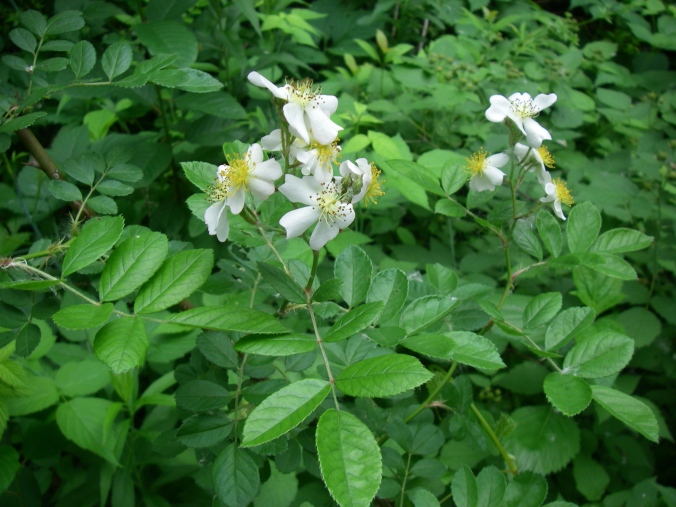Multiflora rose, common privet, and common St. Johnswort are a flowering right now, so keep your eyes out for them! When I first started to learn my plants, it was discouraging to discover that many areas were thick with invasive plants, not native species! But recognizing these invasive species is the first step in restoring our natural areas.
Many of the plants that are invasive here in North America were transported here for a reason. People moving here were used to the plants they used for food, fuel, and fiber, so they brought those plants along on the trip to their new home. Even after living in North America for a century or more, as my relatives have, we often prefer the ornamental plants we are used to, rather than native species. We like these species for a reason: they grow quickly and look nice. The majority of these plant don’t spread into natural areas and displace native plants species. But unfortunately, the “growing quickly” qualifies many of these non-native plant species as prime candidates for being invasive, actually changing the natural areas where they spread to make them less suitable for native plants and animals. Lots of research have found that invasive species are one of the greatest threats to diversity on this planet, so what seems like a harmless decision can have big consequences down the road.
Now invading forests and fields alike, multiflora rose (Rosa multiflora) was widely planted for wildlife habitat and erosion control. Try planting the beautiful native shrub ninebark (Physocarpus opulifolius) instead of multiflora rose.

Multiflora rose (Rosa mutliflora) look pretty and smells good for a few weeks, but the rest of the year it invades natural areas, displacing native plant species.

How can you tell a native rose from multiflora rose? First, multiflora rose has many flowers in a cluster in its inflorescence, while native roses usually only have one to a few flowers in a cluster. Second, if you look at the stalk where the leaf connects to the stem, you’ll find a wing called a “stipule.” Multiflora rose has a feathery look to the stipule, seen in this picture, while native roses do not.
Common privet (Ligustrum vulgare) is widely planted as a hedge, but in our area it has escaped into natural areas, where it grows so thickly that few other species growth with it. There is often a carpet of privet seedling under the adult plants.

Common privet (Ligustrum vulgare) has invaded many natural areas along the Paint Creek Trail.
The last species for today does not transform ecosystems in this area as much as common privet or multiflora rose, but it is an indicator of disturbance. However, in the western United States spotted St. Johnswort (Hypericum perforatum) is recognized as a noxious weed because it crowds out native plant species and is poisonous to cattle.

Common St. Johnswort (Hypericum performatum) has attractive flowers, but can become a noxious weed in certain environments, particularly dry soils in disturbed areas.

The “performatum” part of the scientific name of common St. Johnswort refers to the translucent dots on the leaves that let light shine through. Pretty cool!
Do you see these plants where you live?